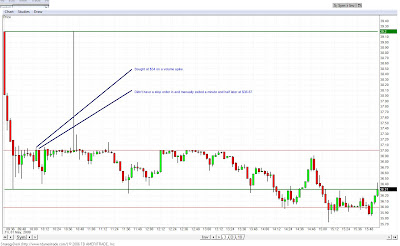I won’t have time to go in such detail my trades every day in a post, but given it’s my first day back trading with real money, I think it’s worth the investment as I start out of the gate.
CHARTS – Green lines are Opening Range High (ORH) and Opening Range Low (ORL) drawn by my software. Red lines are whole number price levels that I put in manually.
AOC ~ SHORT -$26
My first reaction to this pattern was bearish, but I hesitated and missed an entry just above $37. I waited and didn’t chase. The green candle at 10am had a volume spike on my other “confirmation” chart, and I played the trade as a “bottom bounce”, and went long. The stock was moving so quick I didn’t even have time to put in a stop order and manually exited a minute and half later. Some lessons:
1) I have found that my first impressions often are more accurate than my second guesses.
2) My trading platform allows me to put in both an entry order and stop order at the same time, and I need to submit both before getting into a trade as stocks can move fast and I make emotional decisions when I don’t have a stop order in for a position.
JRCC ~ SHORT +$2
I saw the ORH acting as strong resistance and traded the stock as a “ORH Fade” set-up. My price target of $17.00 was never hit and I only would of made $20 at most on a manually moved trailing stop, but that would of been better than my exit near break even. Lesson:
3) Leave my initial stop orders in to let trades develop, don’t override them to relieve my mental discomfort; when a stock makes a move in my favor, put the manual trailing stop in per my rules but don’t override the stop orders on emotion.
MFE ~ LONG -$6
Thought this would bounce off $40, which was possibly acting as a floodgate from what I could tell by Level II. I figured if it broke through that level, it would drop quickly. So after longing, I had a flip order in to sell 400 shares at $39.95 so I would be short, but my prop firm didn’t allow this order to go through (and I didn’t know that until price tanked quickly and my stop order was not filled) because it exceeded my 200 limit per transaction. So if I want to flip in the future, I will have to do it through two separate orders. It did drop a quarter under $40 but it was quick and soon consolidated at this price level before bouncing back up to ORH as my original analysis. Lesson:
4) Logistics of flipping with my prop firm.
5) I need to enter after a stock consolidates at least for a candle or two, or I will get whipsawed to equity death over the long-term.
DF ~ SHORT -$23
My entry was not good on this one, but I handled exiting after my stop order was blown through decently. Because the stock was moving so quick, I gave it more room to breath as it was a dime against me immediately. Again, another reason to put in my stop order at the same time I put in my entry order.
PKI ~ LONG -$14
Entered patiently on a pullback rather than chasing, but manually over-rode my stop order on this ORH breakout. I got shook-out by a very short red candle just before it moved to hit my price target. On this one, I would of taken profit at $17.50, and likely would of placed a manual trailing stop at $17.29 – which never would of been hit. Now if I didn’t override that stop order like I did most of the day, I probably would of exited at EOD for around $17.45 for a $75 potential gain.
FLIR ~ SHORT +$29
My only winning trade of day – and I played this “Top Fade” as good as I could have.
The bright spot is that I traded in the right direction four out of six stocks today (and my first reaction was correct on another). While none of them made giant moves (like over a $1), the overall way things went is consistent with my past trading – my analysis on the direction of stocks is typically decently better than a coin flip most days. The bigger problems are managing my entries and exits. I tend to:
1) Chase, don’t wait to enter on pull-backs or bounce-ups, and get in on longer candles (rather than consolidations) – and often get whipsawed out of positions.
2) Override initial stop orders (pulling them to manually exit) and/or don’t get a stop order in at all and sell/cover on emotion rather than technicals – which happened in the past with real trading but is not a big issue with my recent paper trades.
3) In general, don’t let trades extend to their fullest and don’t let winners run – though in my paper trading the 200 share positions with partial profit taking and manual moving stops improved this greatly.
I will keep fine-tuning my analysis and identification of set-ups, but I believe my entries and exits post my initial trade decision are the bigger issues.









